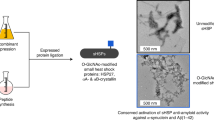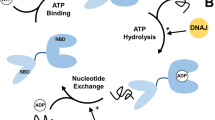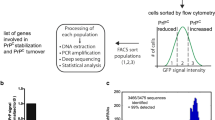Abstract
Polyglutamine (polyQ) repeat expansions that lead to the formation of amyloid aggregates are linked to several devastating neurodegenerative disorders. While molecular chaperones, including the small heat shock proteins (sHsp), play an important role in protection against protein misfolding, the aberrant protein folding that accompanies these polyQ diseases overwhelms the chaperone network. By generating a model structure to explain the observed suppression of spinocerebellar ataxia 3 (SCA3) by the sHsp αB-crystallin, we have identified key vulnerabilities that provide a possible mechanism to explain this heat shock response. A docking study involving a small bioactive peptide should also aid in the development of new drug targets for the prevention of polyQ-based aggregation.




Similar content being viewed by others
References
Taylor, J. P., Hardy, J., & Fischbeck, K. H. (2002). Toxic proteins in neurodegenerative disease. Science, 296, 1991–1995.
Ellisdon, A. M., Thomas, B., & Bottomley, S. P. (2006). The two-stage pathway of ataxin-3 fibrillogenesis involves a polyglutamine-independent step. Journal of Biological Chemistry, 281, 16888–16896.
Thakur, A. K., Jayaraman, M., Mishra, R., Thakur, M., Chellgren, V. M., Byeon, I. J., et al. (2009). Polyglutamine disruption of the huntingtin exon 1 N terminus triggers a complex aggregation mechanism. Nature Structural & Molecular Biology, 16, 380–389.
de Chiara, C., Menon, R. P., Adinolfi, S., de Boer, J., Ktistaki, E., Kelly, G., et al. (2005). The AXH domain adopts alternative folds the solution structure of HBP1 AXH. Structure, 13, 743–753.
Ecroyd, H., & Carver, J. A. (2009). Crystallin proteins and amyloid fibrils. Cellular and Molecular Life Sciences, 66, 62–81.
Horwitz, J. (2003). Alpha-crystallin. Experimental Eye Research, 76, 145–153.
Gu, L., Abulimiti, A., Li, W., & Chang, Z. J. (2002). Monodisperse Hsp16.3 nonamer exhibits dynamic dissociation and reassociation, with the nonamer dissociation prerequisite for chaperone-like activity. Journal of Molecular Biology, 319, 517–526.
Claxton, D. P., Zou, P., & Mchaourab, H. S. (2008). Structure and orientation of T4 lysozyme bound to the small heat shock protein alpha-crystallin. Journal of Molecular Biology, 375, 1026–1039.
Ghosh, J. G., Houck, S. A., & Clark, J. I. (2007). Interactive sequences in the stress protein and molecular chaperone human alphaB crystallin recognize and modulate the assembly of filaments. International Journal of Biochemistry & Cell Biology, 39, 1804–1815.
Bilen, J., & Bonini, N. M. (2007). Genome-wide screen for modifiers of ataxin-3 neurodegeneration in Drosophila. PLoS Genetics, 3, 1950–1964.
Robertson, A. L., Headeyb, S. J., Saunders, H. M., Ecroyd, H., Scanlon, H. M., Carver, J. A., et al. (2010). Small heat-shock proteins interact with a flanking domain to suppress polyglutamine aggregation. Proceedings of the National Academy of Sciences of the USA, 107, 10424–10429.
Fernández, A., & Scheraga, H. (2003). Insufficiently dehydrated hydrogen bonds as determinants of protein interactions. Proceedings of the National Academy of Sciences of the USA, 100, 113–118.
Healy, E. F., Johnson, S., Hauser, C., & King, P. (2009). Tyrosine kinase inhibition: Ligand binding and conformational change in c-Kit and c-Abl. Federation of European Biochemical Societies Letters, 583, 2899–2906.
Healy, E. F. (2011). The effect of desolvation on nucleophilic halogenase activity. Computational and Theoretical Chemistry, 964, 91–93.
Healy, E. F., Romano, P., Mejia, M., & Lindfors, G, I. I. I. (2010). Acetylenic inhibitors of ADAM10 and ADAM17: In silico analysis of potency and selectivity. Journal of Molecular Graphics and Modelling, 29, 436–442.
Fernández, A., & Ridgway, S. (2003). Dehydron: A structure-encoded signal for protein interactions. Biophysical Journal, 85, 1914–1928.
Maddipati, S., & Fernández, A. (2006). Feature-similarity protein classifier as a ligand engineering tool. Biomolecular Engineering, 23, 307–315.
Fernández, A., & Lynch, M. (2011). Nature non-adaptive origins of interactome complexity. Nature, 474, 502–505.
Healy, E. F., & King, P. J. (2012). A mechanism of action for small heat shock proteins. Biochemical and Biophysical Research Communications, 417, 268–273.
Healy, E. F. (2012). A model for heterooligomer formation in the heat shock response of Escherichia coli. Biochemical and Biophysical Research Communications, 420, 639–643.
Brooks, B. R., Bruccoleri, R. E., Olafson, B. D., States, D. J., Swaminathan, S., & Karplus, M. (1983). CHARMM: A program for macromolecular energy, minimization, and dynamics calculations. Journal of Computational Chemistry, 4, 187–217.
Nicastro, G., Menon, R. P., Masino, L., Knowles, P. P., McDonald, N. Q., & Pastore, A. (2005). The solution structure of the Josephin domain of ataxin-3: structural determinants for molecular recognition. Proceedings of the National Academy of Sciences of the USA, 102, 10493–10498.
Chen, R., Li, L., & Weng, Z. (2003). ZDOCK: An initial-stage protein-docking algorithm. Proteins, 52, 80–87.
Pierce, B., & Weng, Z. (2007). ZRANK: Reranking protein docking predictions with an optimized energy function. Proteins-Structure Function and Genetics, 67, 1078–1086.
Huey, R., Morris, G. M., Olson, A. J., & Goodsell, D. S. (2007). A semiempirical free energy force field with charge-based desolvation. Journal of Computational Chemistry, 28, 1145–1152.
AutoDock Tools [http://autodock.scripps.edu/resources/adt/index_html].
Gasteiger, J., & Marsili, M. (1980). Iterative partial equalization of orbital electronegativity—A rapid access to atomic charges. Tetrahedron, 36, 3219–3228.
Morris, G. M., Goodsell, D. S., Halliday, R. S., Huey, R., Hart, W. E., Belew, R. K., et al. (1998). Automated docking using a Lamarckian genetic algorithm and an empirical binding free energy function. Journal of Computational Chemistry, 19, 1639–1662.
Fernández, A., & Berry, R. S. (2003). Proteins with H-bond packing defects are highly interactive with lipid bilayers: Implications for amyloidogenesis. Proceedings of the National Academy of Sciences of the USA, 100, 2391–2396.
Tam, S., Spiess, C., Auyeung, W., Joachimiak, L., Chen, B., Poirier, M. A., et al. (2009). The chaperonin TRiC blocks a huntingtin sequence element that promotes the conformational switch to aggregation. Nature Structural & Molecular Biology, 16, 1279–1285.
Liebman, S. W., & Meredith, S. C. (2010). Protein folding: sticky N17 speeds huntingtin pile-up. Nature Chemical Biology, 6, 7–8.
Acknowledgments
The authors EFH and CL are grateful to the Welch Foundation (Grant # BH-0018) for its continuing support of the Chemistry Department at St. Edward’s University. We thank Dr. Arthur Olson for the AutoDock 4.0 and AutoGrid 4.0 programs. This paper is dedicated to the memory of Woody Guthrie, who on October 3, 1967 died from complications of Huntington’s disease.
Author information
Authors and Affiliations
Corresponding author
Rights and permissions
About this article
Cite this article
Healy, E.F., Little, C. & King, P.J. A Model for Small Heat Shock Protein Inhibition of Polyglutamine Aggregation. Cell Biochem Biophys 69, 275–281 (2014). https://doi.org/10.1007/s12013-013-9795-1
Published:
Issue Date:
DOI: https://doi.org/10.1007/s12013-013-9795-1




